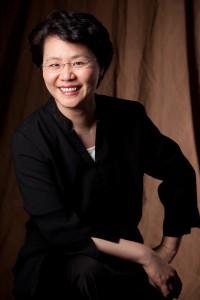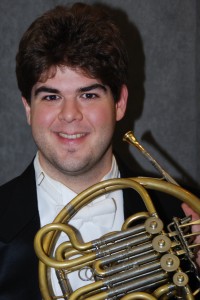Symphonic Trips to Bagdad and Down the Mississippi
“A spoonful of sugar makes the medicine go down,” the opening line of a breezy song from a child-friendly movie of yore, sprang to mind when I perused Friday’s (Feb. 8) San Diego Symphony program. An obscure, 30-minute tone poem “Mississippi River Suite” by the nearly forgotten African-American composer Florence Price was the medicine, and Rimsky-Korsakov’s numbingly familiar “Scheherazade” was the spoonful of sugar on Taiwanese conductor Mei-Ann Chen’s prescription for her inaugural appearance on the local podium.
Between these two tone poems, the orchestra’s Principal Horn Benjamin Jaber came front and center to give his take on Richard Strauss’ First Horn Concerto. Soloing on the horn (pratitioners of this noble instrument cringe when you call it the French horn!) is the orchestral equivalent of a circus high wire act, and Jaber’s success as San Diego’s first chair of the horn section has been based on his ability to tame this unpredictable instrument. The horn is so fickle, it will emit a clam while taking it out of the case, before the poor player has even lifted it to his awaiting embochure.
Security of execution proved Jaber’s calling card throughout the Concerto, and in the
demanding finale, his gleaming, clearly focused sonority made its virtuoso apreggios and flamboyant figures dance. Perhaps he was saving his lip for the finale, but I thought his color was rather opaque and energy a bit low in those more sustained themes of the middle movement. His colleagues on stage joined the Copley Hall audience to give him a thundering ovation.
Few concert-goers (or music majors, for that matter) will recognize the name Florence Price, but in Chicago in the 1930s she was a hot ticket. Her 1932 Symphony in E Minor won a major competition and was performed by the Chicago Symphony under its eminent conductor Frederick Stock. Following that triumph, in 1934 she composed “Mississippi River Suite,” a work that wove African-American spirituals, traditional folk songs and a Native American chant into an expansive orchestral tone poem.
The prolific Price was ahead of the curve in this type of composition. Not until 1936 did Aaron Copland, for example, produce “El Sálon México” and “Billy the Kid,” his first scores to feature, respectively, Mexican and American folk tunes. That same year Virgil Thomson’s music for the film “The Plow that Broke the Plains,” another Mississippi River saga that used folk music, also appeared. All the history books celebrate Copland’s and Thomson’s musical innovations, but they rarely even mention Price. Maybe Price’s status as an Afircan-American woman had something to do with this oversight. Do you think?
In any case, Chen lavished attention on every aspect of Price’s colorful score, a work Chen has championed with her own Chicago Sinfonietta, of which she is Music Director. Not suprisingly, the spiritual “Deep River” flows in and out of the work, giving the Principal Clarinet, English Horn, Trombone and Trumpet (I hope I did not miss anyone) turns at embellishing this effulgent theme. Other spirituals—“Go Down, Moses” and “Nobody Knows the Trouble I’ve Seen”—along with some dance hall themes vary the moods of the piece, whose pace can be described by the line from another river song: it just keeps rollin’ along.
Price’s idiom is harmonically quite conservative, having studied composition with two traditionalists, George W. Chadwick in her student years at the New England Conservatory and Leo Sowerby when she moved to Chicago in the late 1920s. To my ears, “Mississippi River Suite” sounds more like an episodic, easy-going film score than a tight concert work, but it is certainly worth programming. Don’t American audiences identify more with the Mississippi than the Moldau? We could give Smetana’s ubiquitous tone poem an occasional respite now and again and spend time with Price on our own mighty river.
It was rewarding to hear “Scheherazade” given the deluxe treatment by Chen and the orchestra, a patiently detailed account full of ardent, well-turned solos, as opposed to one of those cursory pops concert renditions given in the variable acoustics of an outdoor setting and missing various Principal players off doing “more worthwhile” things.
Kudos to Principal Flute Rose Lombardo for her suave, enchanting solos in the first movement and to Principal Bassoon Valentin Martchev for his telling, well-crafted solos in the second. Concertmaster Jeff Thayer projected alluring, iridescent arabesques in his several solos that symbolize (we believe) the crafty story-telling Sultana, Scheherazade. All the brasses were in top form in the propulsive final movement, but Principal Trumpet Calvin Price won the Olympic gold for those incessant rapid triplets at every dynamic level, a glorious blend of stamina and artistry.
Chen had this score memorized, and her exuberant, athletic style of direction indicated she wanted to be in charge of every minute detail of this grand oriental excursion. The orchestra may not have needed such intense tutelage, but it was hard to complain about the musical results.
[box] Mei-Ann Chen conducts the San Diego Symphony at Copley Symphony Hall Feb. 8 – 10, 2013. Next Jacobs Masterworks performances March 1 – 3, 2013, featuring Music Director Jahja Ling conducting Dvorak’s Sixth Symphony.[/box]





[…] Clearly the answer is “yes,” if we follow Chen’s activities — she led the San Diego Symphony in the Mississippi River Suite in February, and will bring the work to her Memphis Symphony next weekend. She already performed […]
[…] the Memphis Symphony and the Chicago Sinfonietta. Earlier this year she guest conducted with the San Diego Symphony, and on May 9 she made her subscription debut with the Chicago Symphony. This is four orchestras […]